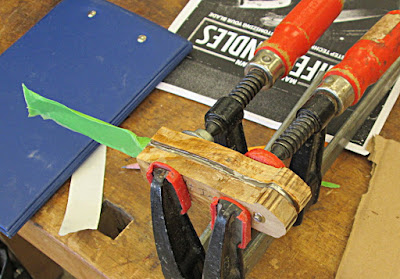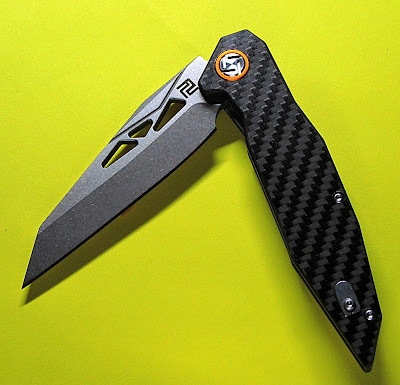The trick or treaters gathered in
homes around Akron and the burgs in preparation for what is a yearly rite of
passage, Halloween. Routes are mapped,
evaluated, altered and re-planned. Last
minute adjustments to costumes and provisions for rain are being made, cancelled
and re-adjusted even as I press my keyboard.
Moms have programmed a route in their GPS. Their SUV will pull up to the driveway, the
door slides open and kids will pour out like an incoming tide.
We too are ready. Two years ago we ran out at 400 pieces and
had to sneak back into the house, turn off the porch light and pretend we
weren’t home. We’re ready this year with
an excessive but undisclosed amount of candy.
Dentists around the city have been sending us thank you notes. Yeah, we have a lot of candy.
 |
| Two of my favorite knives: Mickey Yurko and a Russian Fisherman |
It’s also a two pumpkin year for
us. We always make the mistake of buying
the pumpkin and then deciding how to carve it.
Some designs work better than others, but we try to sandwich our last
minute inspiration onto a pumpkin not suited for it almost every year. What the heck, it’s about having fun.
 |
| Proto artwork |
I selected two knives to work
with. I have an orange and black handled
Mickey Yurco in D2 steel. One of the
cool things Mickey does is he gives all his knives a unique number. I have the 3407th knife he has
made. I bought it because of the blade
and the handle. It always reminds me of
Halloween. If a movie monster jumps me
Halloween night, it is in for a bit of a surprise. This knife cuts.
 |
| Russian Fisherman style knife, not a flay knife |
The second selection was a
Russian fisherman knife with a stacked wafer birch bark handle. The blade is made from one of the Russian
knife steels. The Russians are doing
some amazing metallography and developing interesting steels. It is very much in the puukko style which has
been interesting me more and more. The
long, simple lines of the blade are elegant.
But it is birch bark handle that attracts me.
Anyone who has carved pumpkins
knows the biggest problem is manipulating the blade. Too much pressure and the blade shoots
through the fleshy pumpkin wall like magic and over shoots the endpoint. Too little and the knife gets the idea that
it is Excalibur stuck in the stone and you’re not King Arthur.
 |
| The two best tools |
Look, I have knives. There’s never a shortage of sharp edges around
here, but in truth, do you know what works the best?
The thin bladed Victorinox
kitchen paring knife and a dull, course saw-like blade made for children. The saw gives you the most control shaping
and cutting and paring knife lets you sharpen and open up features to make them
transparent.
I’ve tried a lot of knives for
carving pumpkins. One year I tried to be
edgy with a chainsaw. It took me months
to get the saw cleaned up. Trust me;
you'll be happier with the above recommendation.
I look forward to Halloween all
year. It’s one of the few times I feel
comfortable talking to children I don’t know.
PS: It was rainy, cold, windy and we still had at
least 300 kids.
 |
| BOO! |










